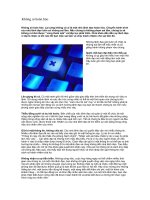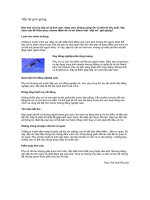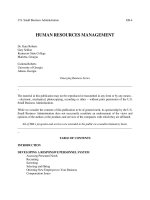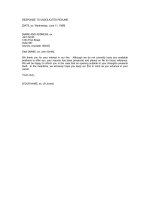Tài liệu E-Human Resource Management 8 docx
Bạn đang xem bản rút gọn của tài liệu. Xem và tải ngay bản đầy đủ của tài liệu tại đây (918.31 KB, 9 trang )
Integrating Handheld Computer Technology 49
Copyright © 2005, Idea Group Inc. Copying or distributing in print or electronic forms without written
permission of Idea Group Inc. is prohibited.
In Figures 5, 6, and 7 are the mean across Delphi groups of the final set
of rankings by occupational group before the consensus round. As shown in
Figure 5, the overall ranking trend across occupation groups was similar across
applications, but there were group differences. The differences were largest for
the applications that were found to be of great importance to one occupational
group and of low importance to another group (i.e., patient data entry to medics
and pharmacists).
Figure 5. Final round mean ratings by occupation: medical functions
1.00
2.00
3.00
4.00
5.00
6.00
7.00
8.00
9.00
10.00
Drug Formularies
References
Medical Calculations
Patient Data Retrieval
Patient Data Entry
Treatment Guidelines
Decision Support
Continuing Medical
Education
Prescription Writing
Administrative
MDA Medical Functions
M
ean Rankin
g
Physician
Pharmacist
Nurse
Medic
Total
50 Davies & Calderón
Copyright © 2005, Idea Group Inc. Copying or distributing in print or electronic forms without written
permission of Idea Group Inc. is prohibited.
In Table 3 are the mean rankings made by the groups for the most important
PIM application types on the handhelds. The rankings also supported the
results from the application usage data and from the logbook results.
There were also differences evident across occupational groups in the Delphi
rankings for the most important PIM applications, as shown in Figure 6. The
differences in group ratings were similar to those found for the medical
applications.
In Table 4 are the mean rankings for the most important areas for change on the
handhelds. This information was not collected in the application usage data, but
it does mirror what was found in the earlier focus groups.
The differences in mean occupational group ratings for “Most Important Areas
for Change” topics are shown in Figure 7. Compared to the two topics
presented in Figures 5 and 6, the differences in mean ratings for “Most
Important Areas for Change” were less clearly defined for all groups.
The transcripts of the Delphi sessions provided a rich source of data. From our
content analysis of these data, the main theme expressed from all five Delphi
sessions was the need for integration between the PDA applications and clinical
work systems. In addition, three sub-themes arose from the main theme: (1)
Table 3. Final ranking of the priorities for 10 personal information
management (PIM) applications
Personal Information Management Functions (All Participants)
Rank
of
Mean
Application
Mean
Rank
1
Calendar/storing appointments 2.5
2
Storing addresses/phone numbers 2.8
3
Number calculation 4.9
4
Writing notes/data 5.0
5
Keeping a “to do” list 5.2
6
Reading/writing e-mail 6.1
7
Alarm function 6.2
8
Accessing notes/data 6.4
9
Storing voice recordings 7.7
10
Entertainment 9.2
Integrating Handheld Computer Technology 51
Copyright © 2005, Idea Group Inc. Copying or distributing in print or electronic forms without written
permission of Idea Group Inc. is prohibited.
1.00
2.00
3.00
4.00
5.00
6.00
7.00
8.00
9.00
10.00
Calendar/ storing
appointments
Storing addresses/phone
numbers
Keeping a “to do” list
Writing notes/data
Number calculation
Accessing notes/data
Reading/writing email
Alarm function
Storing voice recordings
Entertainment
MDA PIM Functions
M
ean Rankin
gs
Physician
Pharmacist
Nurse
Medic
Total
PDA integration with workflow, (2) PDA customization, and (3) PDA stan-
dardization.
Several suggestions were offered to improve the use of the PDA by integrating
it with the daily workflow. Specifically, several comments focused on automat-
ing the workload management (WLM) reporting process for nurses by using
PDA HotSync data. Similarly, participants also believed that the opportunity
to download patient and staff schedules to their PDA calendars would provide
significant time savings to their daily workload. Participants suggested that an
Figure 6. Final round mean ratings by occupation: PIM functions
52 Davies & Calderón
Copyright © 2005, Idea Group Inc. Copying or distributing in print or electronic forms without written
permission of Idea Group Inc. is prohibited.
interface between their PDAs and hospital patient information management
system would allow them to input and extract patient data at the point of care.
By integrating the PDA and hospital patient information management, partici-
pants also envisioned the ability to receive wireless notification of laboratory
results to their PDA, resulting in savings of a considerable amount of time.
Participants expressed the need for their PDA applications to be specific to
their professional specialty. Several participants suggested that the ability to
annotate references and to customize provider-specific applications would be
useful. Similarly, participants expressed the need to customize each PDA’s
applications to the individual, professional group, and medical specialty area
(e.g., gastroenterology or pediatrics reference materials for nurses). Partici-
pants also desired facility-specific applications (e.g., facility-specific drug
formulary and staff telephone/address book) adaptable to their PDA. Finally,
some participants suggested that the use of multilingual translations (Spanish,
Table 4. Ranking of the priorities for 12 “Most Important Areas for
Change in the PDA”
Most Important Areas for Change (All Participants)
Rank
of
Mean
Application
M
ean
R
ank
1
Interface with hospital information systems 2.0
2
Memory size and type 5.5
3
Downloading applications to PDA 5.7
4
Drug formulary/drug database 5.9
5
Monochrome display 5.9
6
Readability 6.4
7
Accuracy/reliability of medical decision support
applications
6.4
8
Pen (handwriting recognition) versus keyboard data input 7.5
9
Organization of reader applications (i.e., index) 7.5
10
Application familiarity (e.g., look and feel, content) 7.8
1
1
General navigation in applications 8.0
1
2
Calculator 9.7
Integrating Handheld Computer Technology 53
Copyright © 2005, Idea Group Inc. Copying or distributing in print or electronic forms without written
permission of Idea Group Inc. is prohibited.
Figure 7. Final round mean ratings by occupation: “Most Important
Areas for Change”
Mean First Round Delphi Rankings By Occupational Group Across
Sites (Most Important Changes Needed in PDA)
1.00
2.00
3.00
4.00
5.00
6.00
7.00
8.00
9.00
10.00
11.00
12.00
Interface with Hospital information systems
Downloading applications to MDA
Drug formulary/ drug database
Memory size & type
Readability
Accuracy/ reliability of medical decision support a
pplications
Monochrome display
General navigation in applications
Pen versus keyboard data input
Organization of reader application (i.e., index)
Application familiarity (e.g., look and feel, content)
Calculator
Most Important Changes Needed
M
ean Rankin
g
Physician
Pharmacist
Nurse
Medic
Total
54 Davies & Calderón
Copyright © 2005, Idea Group Inc. Copying or distributing in print or electronic forms without written
permission of Idea Group Inc. is prohibited.
Chinese, etc.) in each application would be helpful when they are on duty in
foreign countries, and when providing care to non-English-speaking patients.
The third sub-theme that arose during the five sessions, standardization,
primarily focused on the reliability of the PDA when utilizing it in the clinical
workplace (e.g., checking drug dosages, writing prescriptions). Participants
wanted each application standardized and reliable across locations to help
meet medical certification guidelines. To ease the transition to a PDA-based
process, participants also suggested that the forms-based data input screens on
their PDA be similar to the current paper-based forms. Finally, participants
wanted to incorporate medical error reporting features into the PDA application.
Discussion
Although there was a fairly high attrition rate among the participants, we judged
the overall study design and implementation a success. We were able to show
that regardless of previous experience, participants were able to use the
handheld computers with little training. Also, we were able to show that the
handheld computers were useful for providing HR-practice-related applica-
tions and for the collection of research data for a variety of HR-related needs.
Finally, we found that as a byproduct of handheld use, rudimentary job analysis
data could be collected passively from the participants.
That the participants were able to use the handhelds effectively with little
training and even less organizational support was an important finding. With
only three training sessions provided and minimal follow-up support, most
participants were able to successfully utilize the handheld hardware and
applications to enhance their work. However, we found one primary support
dimension lacking for the participants — integration of the handhelds with the
organizational IT system. This lack of support from the IT system resulted in
most of the reported usage problems in the study and was the foundation for
including this factor in our model (Figure 1).
Our results did show that the handheld could be used successfully to deliver
applications and collect data such as that needed for HR practice and research.
The logbook application was well received and did show that standardized
questionnaires could be administered over a handheld platform. The basic PIM
applications were utilized in a work-related fashion and would be beneficial to
capturing schedules and contacts across an organization. Finally, with access
to a wireless network, the participants reported that they would have utilized
Integrating Handheld Computer Technology 55
Copyright © 2005, Idea Group Inc. Copying or distributing in print or electronic forms without written
permission of Idea Group Inc. is prohibited.
forms-based reporting of many administrative work functions. From these
results, the second factor in our model in Figure 1 was supported.
Our last claim in the first paragraph of this discussion section, that rudimentary
job analysis data can be collected passively from the handheld use, was a
primary finding of this study and was supported through the logbook, applica-
tion usage, and focus group data. The logbook data did show that the handheld
computer is useful for collecting job-related information in a standardized
format in real time. The application usage data did show that patterns of work-
related behaviors, specific to occupation, can be inferred from the applications
used by an individual. This is the linchpin in the model presented in Figure 1, that
the handheld can be used to provide useful applications in the workplace (i.e.,
for conducting work and administering strategic HR functions), and through this
use, valuable HR-related research data can be collected and utilized.
Handheld technology must be introduced with careful attention to existing
workflow processes and possibly combined with process reengineering to take
advantage of the mobile and wireless functions. As depicted in the Delphi
sessions, there were requests for a single “system” rather than a myriad of
disconnected, stand-alone applications. In general, the results from this study
should be utilized as a framework for future assessments of handhelds in the
workplace.
Our plans for continuing this line of research involves “process reengineering”
to permit and facilitate the integration of handheld technology into the clinical
and administrative processes utilized by healthcare providers. We plan to
examine clinical business practices to evaluate how workflows can be modified
to take maximum advantage of handheld technologies. By identifying locations
in workflow processes to insert and implement handheld technologies, as well
as performance measurement indicators, we will be able to evaluate the impact
of handhelds on work performance.
Beyond the Current Research:
HR Functions on Handhelds
Beyond the current organizational research that is utilizing handheld technol-
ogy, there are additional HR functions that could be streamlined via handheld
computers. These include areas within performance appraisal/management,
selection, and training.
56 Davies & Calderón
Copyright © 2005, Idea Group Inc. Copying or distributing in print or electronic forms without written
permission of Idea Group Inc. is prohibited.
Performance Appraisal
A key concern within the performance appraisal framework, for example, has
been the accuracy of the ratings provided by raters. Two proposed solutions
to this concern have been frame-of-reference (FOR) training (Murphy &
Cleveland, 1991) and behavioral diaries (Sulsky & Day, 1994; Maurer,
Palmer, & Ashe, 1993). With frame-of-reference training, a set of raters will
typically view vignettes that contain critical incidents of job performance. Each
of these is designed to contain examples of outstanding, average, and unsatis-
factory performance, and raters are asked to rate the behaviors within the
vignettes and provide justification for their ratings. Trainers then inform the
raters about what the intended ratings were supposed to be; a discussion
follows to determine where there are discrepancies between the “true” ratings
and the ratings the individuals provided (Keown-Gerrard & Sulsky, 2001).
This calibration task then serves to provide a consistent “frame-of-reference”
that is used to evaluate actual performance as it is observed and subsequently
rated. In other words, a common framework is established that has been shown
to increase ‘interrater’ agreement on performance ratings. Subsequently, this
increase in interrater agreement has been shown to positively impact the
accuracy of the performance ratings (McIntyre, Smith, & Hassett, 1984).
With behavioral diaries, raters keep a diary of each ratee’s behavior throughout
the performance appraisal cycle (Murphy & Cleveland, 1995). These do not
need to include lengthy entries on a daily basis, but rather should be meaningful
entries of critical incidents that can serve as retrieval cues when it is time to
appraise. The rationale is that the rater will then be able to access the behaviors
within the journal instead of relying strictly on memory, which can affect
accuracy. Furthermore, the diaries will allow raters to establish more accurate
descriptions of “typical” performance. Often times a rater can recall extreme
performance (either good or bad), but often struggles to describe average
performance. The diaries will allow raters to document the full range of each
ratee’s performance. Lastly, the diaries may help raters organize information
into meaningful performance categories (DeNisi, Robbins, & Cafferty, 1989).
Unfortunately, very little technology has been utilized within the performance
appraisal framework. However, the opportunities available for technology to
address certain issues that can directly affect rating accuracy are limitless. For
example, in frame-of-reference training, raters typically work through the initial
exercise that is used to calibrate the various raters. However, over time, the
raters may become forgetful of what was meant by the different levels of
Integrating Handheld Computer Technology 57
Copyright © 2005, Idea Group Inc. Copying or distributing in print or electronic forms without written
permission of Idea Group Inc. is prohibited.
performance. This could lead to a decrease in the accuracy of the ratings, which
is a key concern within the literature (Murphy & Cleveland, 1991). A quick
reference of the different critical incidents that define outstanding, average, and
unsatisfactory performance on something like a handheld computer would be
both easy for the rater and would ensure the frame-of-reference training is not
lost over time. Furthermore, there may be different sets of criteria for different
jobs, and all of this could be centrally located and easily accessible via a
handheld computer.
A handheld computer would also be a logical choice for keeping track of a
ratee’s performance over the period of performance (i.e., an electronic diary).
Often times, raters do not take the time to fill in their diaries, or they do not have
their diaries handy when certain critical incidents occur during the period of
performance. With the handheld computer, the rater would always be able to
track performance; this would help in providing accurate examples during the
performance review. The handheld computer would also make the categoriza-
tion of critical incidents into performance dimensions a more manageable task.
For example, the handheld computer would allow individuals to search,
reconfigure, and crunch data quickly from anywhere (Greene, 2001). This
would enable individuals to determine where more data is needed (e.g., certain
performance dimensions that do not have any behavioral indicators) as well as
sort the data that has already been gathered.
Specifically, a handheld computer would be valuable in both storing and
retrieving information on employees which are the areas that often times impact
the accuracy of the ratings (i.e., raters have difficulty retaining critical incidents
on employees — and often they are responsible for multiple employees — and
subsequently retrieving representative behavioral examples of performance
over a set period of time). The use of a handheld computer to directly enter
performance data would also eliminate the need for later manual data entry of
responses written on paper forms (Fletcher, Erickson, Toomey, & Wagenaar,
2003).
Furthermore, by tracking critical incidents of ratee performance as they occur,
this will also help in the development (or revising) of the performance appraisal
system. The typical method for creating a performance appraisal rating form is
to gather a large number of critical incidents that are then sorted into unique
performance dimensions. Information contained within each critical incident is
then used to define what is meant by good, average, and poor performance via
specific behavioral examples (Murphy & Cleveland, 1991; Sanchez & De La
Torre, 1996; Smith & Kendall, 1963). A typical problem with this type of









